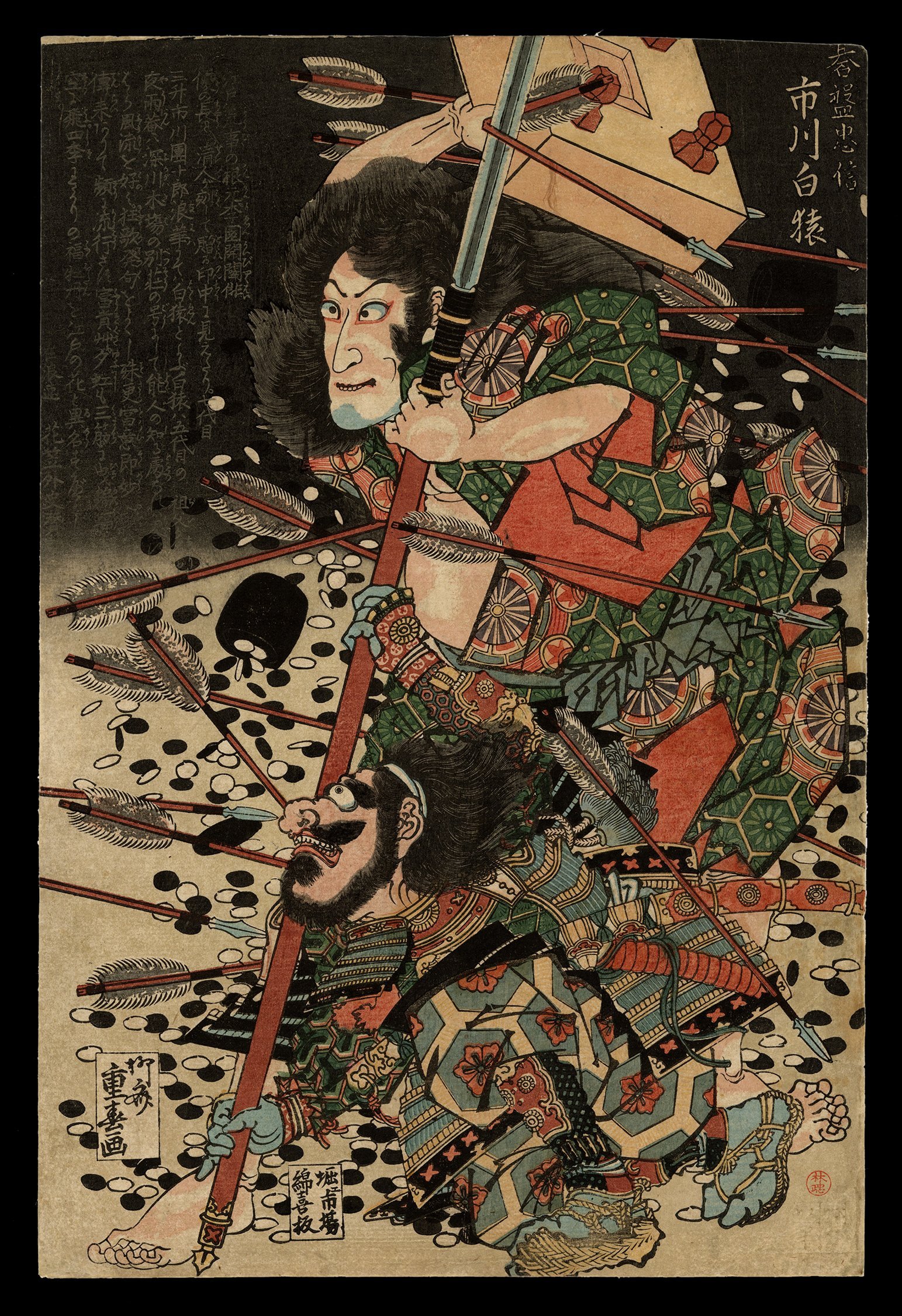 Image 1 of
Image 1 of

<b>ICHIKAWA HAKUEN II</b>Ryusai Shigeharuc.1830$4,500</em>
Ichikawa Hakuen II
Ryusai Shigeharu
MEDIUM: Woodblock Print
DATE: c.1830
DIMENSIONS: 15 x 10 inches
CONDITION: Excellent impression with the text at the upper left well preserved; very slight fading and minor trimming
PROVENANCE: The eminent ukiyo-e dealer Hayashi Tadamasa (1853-1906); small red circular Hayashi seal at lower right
$4,500.00
Ichikawa Hakuen II
Ryusai Shigeharu
MEDIUM: Woodblock Print
DATE: c.1830
DIMENSIONS: 15 x 10 inches
CONDITION: Excellent impression with the text at the upper left well preserved; very slight fading and minor trimming
PROVENANCE: The eminent ukiyo-e dealer Hayashi Tadamasa (1853-1906); small red circular Hayashi seal at lower right
$4,500.00
Ichikawa Hakuen II
Ryusai Shigeharu
MEDIUM: Woodblock Print
DATE: c.1830
DIMENSIONS: 15 x 10 inches
CONDITION: Excellent impression with the text at the upper left well preserved; very slight fading and minor trimming
PROVENANCE: The eminent ukiyo-e dealer Hayashi Tadamasa (1853-1906); small red circular Hayashi seal at lower right
$4,500.00
Details
Ichikawa Hakuen II (市川白猿) was the temporary acting name of the Edo superstar Ichikawa Danjûrô VII (市川團十郎 1791-1859), who performed briefly (5/1829 to 3/1830) in Osaka after fires destroyed all three Edo theaters (Nakamura-za, Ichimura-za, and Kawarazaki-za) in 3/1829. Hakuen also performed in Sakai and Kyoto in the tenth and eleventh months of 1829, respectively, and toured Ise, Nagoya, and Tateyama in Spring and Summer of 1830 before returning to Edo in 8/1830. Hakuen’s appearance in Osaka caused quite a sensation as kabuki fans filled the theaters to watch him perform.
The retainer Satô Shirô Tadanobu (佐藤四郎忠信) was an ally and protector of Lady Shizuka Gozen (1165-1211: 静御前), the concubine of the legendary warrior Minamoto no Yoshitsune (1159-1189, 源義経), who was in flight from his half-brother Minamoto no Yoritomo (1147-1199, 源頼朝), Japan's military leader. In the kabuki scene depicted by Shigeharu, Tadanobu, unable to reach his weapons, fights off his attackers with a “go” game board (goban, 碁盤), which he lifts above his head, using it as a weapon and a shield. Finally, when all is lost, he takes his own life rather than be taken prisoner.
The role of Tadanobu appears in a variety of kabuki and puppet plays. In many of these dramas, the character is actually a fox spirit using Yoshitsune’s name (“Genkurô,” meaning “Minamoto ninth son,” 源九郎) as the creature takes on the human form of the true Tadanobu. In Shigeharu’s portrayal, Tadanobu performs in the "wild business" (aragoto, 荒事) manner championed by the Ichikawa acting lineage and generally favored in Edo, rather than the “soft stuff” (wagoto, 和事) acting style more characteristic of Osaka kabuki. However, both aragoto and wagoto were found on the stages of the two cities.
Connoisseur's Note
The style of portrayal used by Shigeharu was undoubtedly influenced by the Edo master Utagawa Kuniyoshi’s woodcut series “The 108 heroes of the Suikoden” (Tsûzoku suikoden gôketsu hyakuhachinin no hitori, 通俗水滸傳豪傑百八人之一個), which, in 1827, rocked the printmaking world and bestowed widespread fame upon Kuniyoshi. His series portrayed legendary Chinese heroes from a hugely popular semi-fictional saga, “Tales of the Water Margin” (水滸傳;, Ch., Sui Ho Chuan or Shui Hu Zhuan). Based on the fourteenth-century Chinese novel, the Suikoden was a rousing and bloody epic celebrating the exploits of a band of righteous outlaws led by Song Jiang, whose base of operations was an encampment by a marsh (the "water margin" of the title) on Mount Liang (Liangshan; Jp., Ryôsanpaku).
The Osaka printmaking world was quite familiar with kabuki plays and actor-print productions originating in Edo, and, on rare occasions, Osaka artists would try their hand at chronicling subjects celebrated in Edo. Thus, in this print, Shigenobu presents the Edo stage idol Ichikawa Hakuen II in a manner consistent with Edo kabuki and aragoto actor mannerisms. Hakuen’s fierce facial expression is presented in the Edo style — brave and defiant despite the hail of arrows. Tumbling go game pieces add to the visual and emotional chaos. The shading on the face, arms, and belly were derived at least in part from Kuniyoshi’s stylized manner of chiaroscuro adapted from what he had seen of art works from the West.
The long text at the upper left is a panegyric for Ichikawa Hakuen II. The commentary is signed at the far lower left by the author and poet Hanagasa Gaishi (花笠外史). Hanagasa’s biography appears to be largely unknown. He might have used the alternative name Hanagasa Bunkyô (花笠文京 1785-1860), but this conjecture seems not to be entirely secure. Hanagasa produced, among other things, popular fiction and was active circa 1830s-1850s.
All told, this is just the sort of rare woodcut design that Osaka print specialists covet. On display here is an Edo kabuki superstar drawn in the “wild business” style while appearing in an imaginary performance. Better still, the impression is excellent and it once passed through the expert hands of Hayashi Tadamasa, one of the great early connoisseurs in ukiyo-e collecting history.

